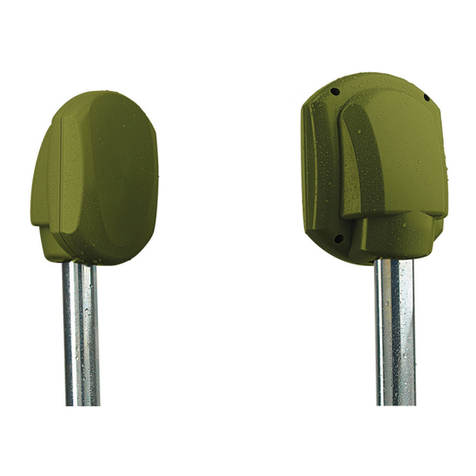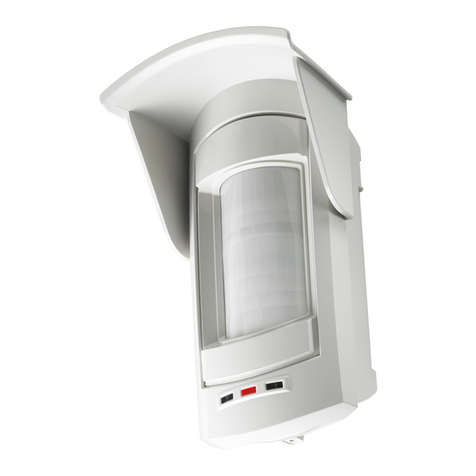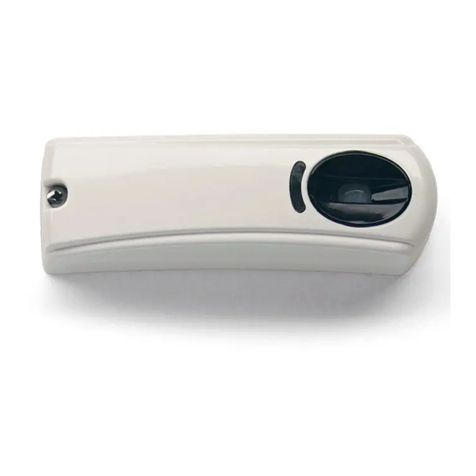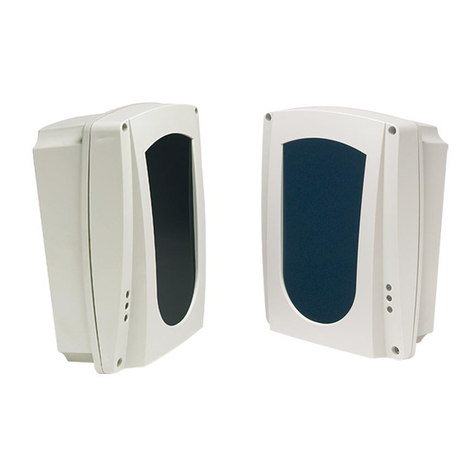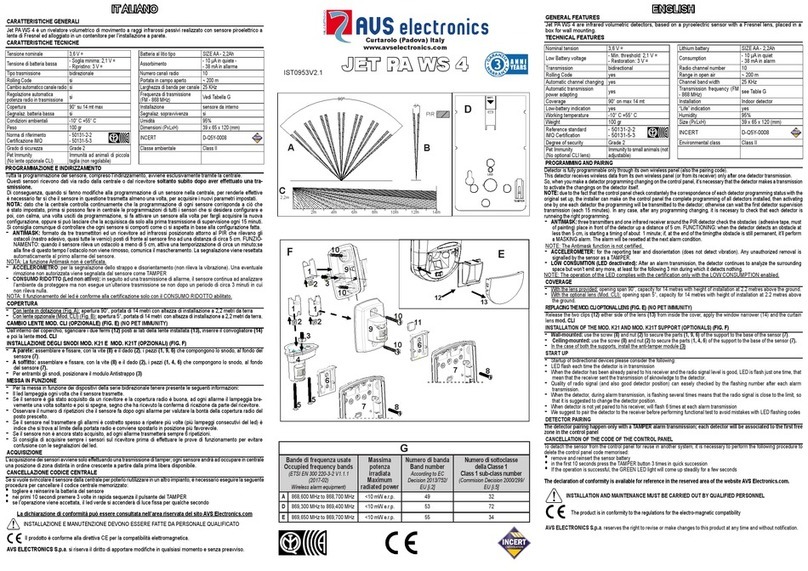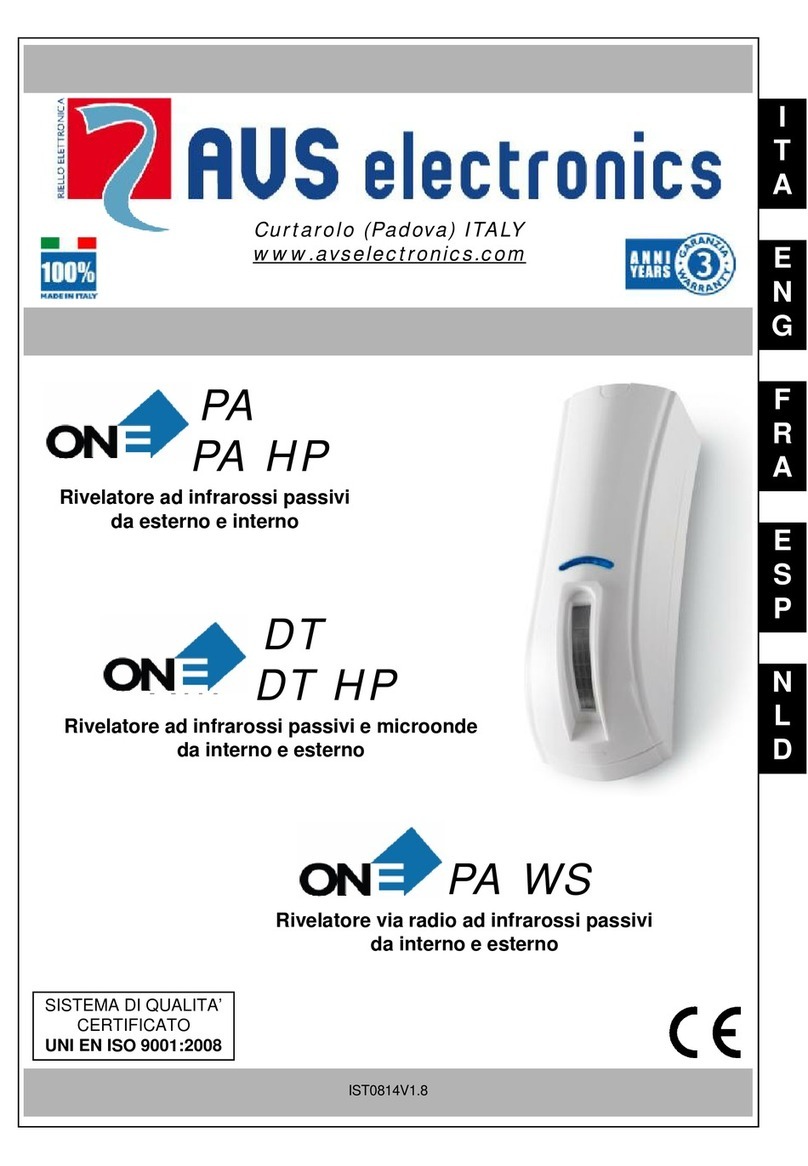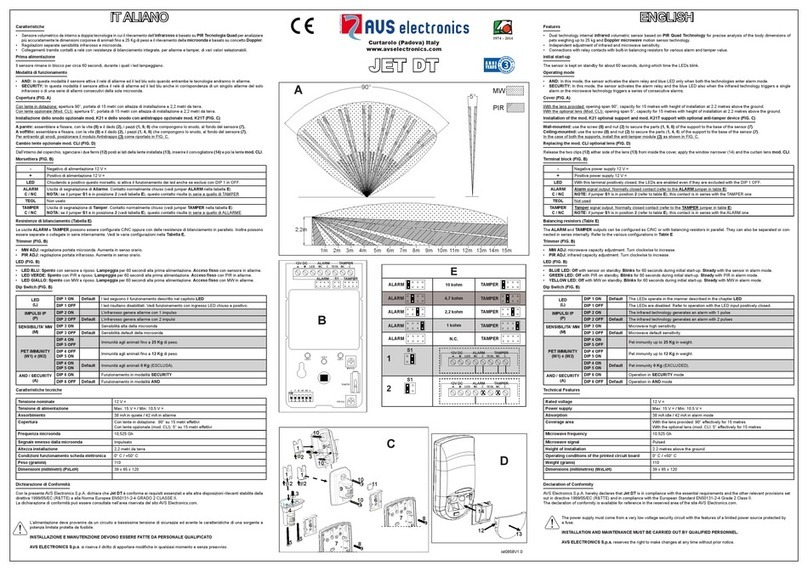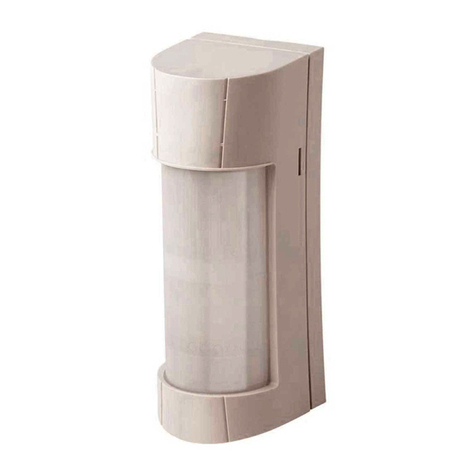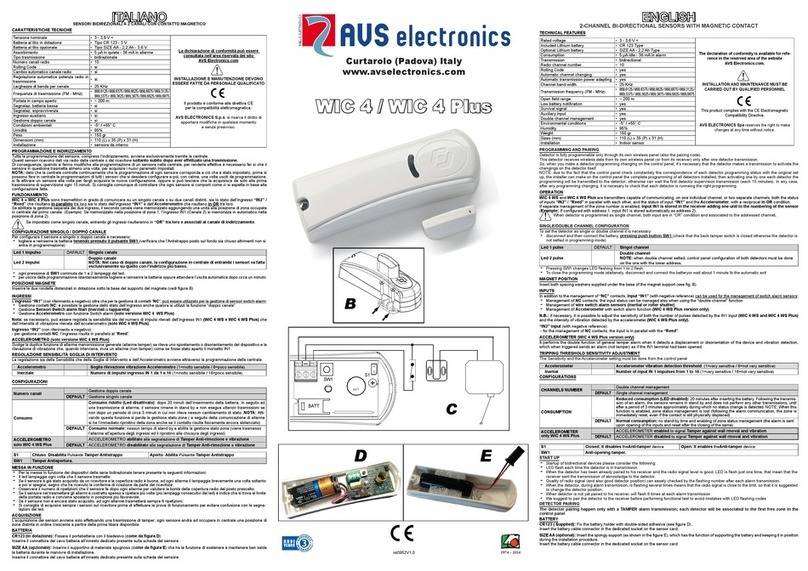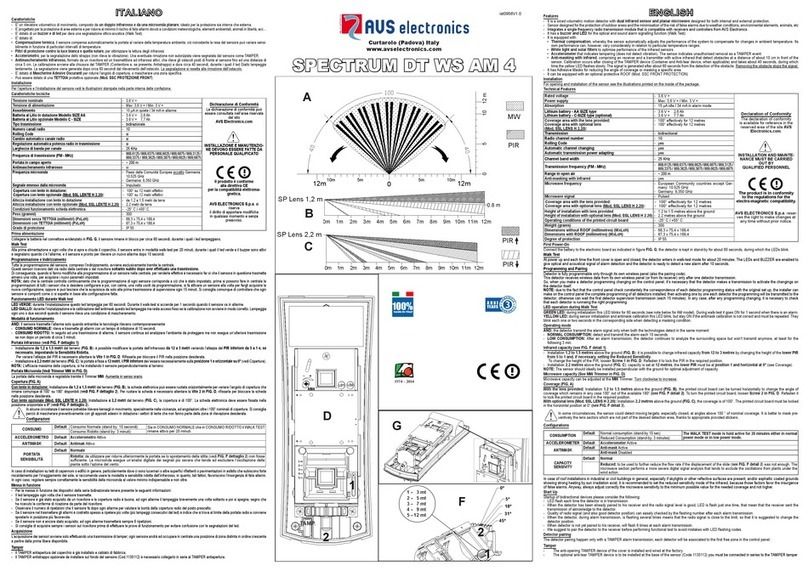
3- BASE SENSORE
AeterapaoiggassiflireporoF
B°54idelaretalenoizanilcninoceterapaoiggassiflirepiroF
CovacassapelanaC
DodonsolotazzilitueneivesovacassaporofoeterapaesaballedoiggassifreporoF
EodonsollaesaballedoiggassiflirepiroF
FoihcrepocledoccolblirepetiV
GovacassaporofrepotivnI
Prima di effettuare le operazioni descritte successivamente, assicu-
rarsi di aver estratto la scheda elettronica dalla base per evitare di
danneggiarla.
1- PARAMETRI DI FUNZIONAMENTO
•Durata dell’impulso: la durata di ogni impulso deve rientrare in una determinata fine-
stra temporale.
•Ampiezza dell’impulso: l’ampiezza del segnale deve essere superiore ad una gran-
dezza prefissata, per evitare allarmi indesiderati.
•Distanza relativa tra impulsi: il segnale viene riconosciuto come valido soltanto se
almeno due impulsi sono compresi in un determinato intervallo di tempo.
2- CONSIGLI PER L’INSTALLAZIONE
•Scegliere con cura la posizione del sensore, tenendo presente che la microonda rile-
va con maggiore sensibilità i movimenti di avvicinamento e allontanamento dal sensore
e con minore sensibilità i movimenti trasversali.
•Fissare il sensore su superfici stabili e prive di vibrazioni, ad un’altezza compresa tra
i 2 e 2,30 metri.
•Evitare di puntare il sensore su lampade fluorescenti.
•Usare cavo schermato (sezione 0.50mm per l’alimentazione), collegando la schermatura
al negativo soltanto nella centrale e non nel sensore.
BASE LATO ESTERNO
Eseguire un foro ( massimo Ø 12
mm) in corrispondenza della predi-
sposizione, per il passaggio del
cavo e per permettere il successi-
vo blocco dello snodo.
BASE LATO INTERNO
Eseguire i due fori Ø 3,5 mm per il
fissaggio della base sullo snodo,
nelle posizioni indicate in figura.
Utilizzare la vite di fissaggio lunga
(M3x12) dal lato del foro E2e quel-
la corta (M3x8) dal lato del foro E1.
E2
D
Una volta trovata l’inclinazio-
ne più consona per il senso-
re, fissare la vite di blocco
dello snodo (in figura è indicata
la posizione della vite di blocco).
B
C
F
C
G
E2
B
E1
A
B
D
E1
B
6 - MORSETTIERA
5- ANTISTRAPPO (Mod. KBT)
Forare la parete in corrispondenza del tamper di antistrappo
posto sul fondo dello snodo.
Avvitare sul tassello la vite a testa svasata, fino a farla
aderire al muro.
AM: Uscita Anti-mascheramento
All’alimentazione il circuito di antimascheramento esegue
un’autoregolazione. In questa fase è essenziale che il co-
perchio sia regolarmente installato per permettere al
sensore di regolarsi sul valore corretto.
Il circuito anti-mascheramento fornisce un segnale di allarme
se viene mantenuto per più di un minuto del materiale metallico
frontalmente al sensore e ad una distanza massima di 20 cm.
Il led giallo inizia a lampeggiare non appena il sensore inizia a rilevare un tentativo di maschera-
mento, se dopo un minuto la causa di mascheramento persiste, si attiva l’uscita dedicata AM che
fornisce un negativo transistorizzato ed il led giallo si accende di luce fissa.
Entrambe le segnalazioni vengono resettate automaticamente al primo allarme del sensore.
La funzione anti-mascheramento può essere attiva sia a centrale accesa che spenta.
NOTA: questa funzione non garantisce comunque che il sensore non possa essere
mascherato.
B: Ingresso di Blocco
Al morsetto (B) di blocco, deve essere fornito un positivo a centrale spenta, al fine di bloccare il
funzionamento del sensore stesso:
•Blocco del relè di allarme nella condizione di riposo (NC)
•Blocco completo dell'alimentazione della microonda
•Blocco della funzione anti-mascheramento
Se utilizzato il comando di blocco, l'attivazione del relè del sensore avviene 30 secondi
dopo la mancanza del positivo al morsetto (B).
Integrando il contatto an-
tistrappo posto sul fondo
dellosnodoalcircuitoan-
tiapertura del sensore, si ottiene una pre-
stazione al 2° Livello IMQ.
Per bloccare il coperchio, utilizzare
la vite in dotazione.
Di fabbrica la vite viene posizionata
nella base del sensore (contrassegnata con
la lettera F nella tabella BASE SENSORE) .
99
99
9
- CHIUSURA SENSORE- CHIUSURA SENSORE
- CHIUSURA SENSORE- CHIUSURA SENSORE
- CHIUSURA SENSORE
88
88
8
--
--
- TT
TT
TARAARA
ARAARA
ARATURA DEL SENSORETURA DEL SENSORE
TURA DEL SENSORETURA DEL SENSORE
TURA DEL SENSORE
7 - DIP SWITCH, JUMPER e TRIMMER
+V21enoizatnemilaidovitisoP
-enoizatnemilaidovitageN
CAm001V21atatropnocerosnesledemrallaidottatnoC osopiraerosnesnocosuihcetnemlamroN
CN
TenoissimonamitnaidaeniL asuihcetnemlamroN
T
BoccolBidottesroM
MA otnemarehcsam-itnaaticsU
tluafedidenoizatsopmi:HCTIWSPID 1 2 3 4
MYPS FFO FFO FFO FFO
²MYPS FFO FFO FFO FFO
OTNEMAREHCSAMITNAENOIZALANGES-2PID FFO alosalladenoizavitta'lacovorperosnesledotnemarehcsamlI MAaticsu
NO aisenoizavitta'lacovorperosnesledotnemarehcsamlI emrallaidèlerledehcMAaticsu'lled
DELOTNEMANOIZNUF-1PID
NO OSSOR
OLLAIG
adnoorcimalledemrallaidenoizalangeS eroirepus adnoorcimalledemrallaidenoizalangeS )²MYPSolos(eroirefni
FFO )tluafeD( OSSOR OLLAIG erosnesledemrallaidenoizalangeS KSAMITNAemrallaidenoizalangeS
EDNOORCIMATATROP-REMMIRT 1VR )²MYPSolos( alledatatropalledenoizalogeralrepremmirT eroirefniadnoorcim Bosnesniolodnatour( .)aminimatatropaleneittoisoiraroitna
2VR alledatatropalledenoizalogeralrepremmirT eroirepusadnoorcim Aosnesniolodnatour( .)aminimatatropaleneittoisoiraroitna
3VR otasunoN
Per il corretto funzionamento del sensore, è obbligatorio eseguire la taratura.
Questa deve essere effettuata dopo almeno 1 minuto dalla prima alimentazione
o 30 secondi dallo sblocco (tolto positivo di blocco dal morsetto B).
OSSORDELFFO-1SREPMUJOSUIHC )tluafeD(otatilibaossordel
OTREPA otatilibasidossordel
3- BASE OF THE DETECTORBASE OF THE DETECTOR
BASE OF THE DETECTORBASE OF THE DETECTOR
BASE OF THE DETECTOR
AllawehtotnoitaxifrofeloH
B°54fonoitanilcnihtiwllawehtotnoitaxifrofseloH
Clennahcelbac-gnissaP
Ddesusileviwsehtfielohelbac-gnissaprollawehtotesabehtfonoitaxifrofeloH
EleviwsehtotesabehtfonoitaxifrofseloH
FgnikcolbrevocrofwercS
Gelohelbac-gnissapotediuG
Before making the following operations here described, be sure you
have taken off the electronic board from the base in order not to damage
it.
1- WORKING PARAMETERSWORKING PARAMETERS
WORKING PARAMETERSWORKING PARAMETERS
WORKING PARAMETERS
2- RECOMMANDATION FOR INSTALLATIONRECOMMANDATION FOR INSTALLATION
RECOMMANDATION FOR INSTALLATIONRECOMMANDATION FOR INSTALLATION
RECOMMANDATION FOR INSTALLATION
•Choose carefully the position of the detector, reminding that microwave detects the
movements of approaching and leaving with higher sensitivity and the crossing
movements with reduced sensitivity
•Fix the detector onto stable and no-vibrating surfaces at a height between 2 and 2,3
meters
•Do not point the detector towards fluorescent lamps
•Use shielded cable (0,5 for supplying), connecting the shield to the negative only on
the control panel, and not on the detector.
BASE - EXTERNAL SIDE
Make a hole (max Ø 12 mm) in
correspondance of the
predisposition, for the cable passing
and to then allow the block of the
swivel.
BASE - INTERNAL SIDE
Make the two Ø 3,5 mm holes to fix
the base to the swivel, as shown in
the picture.
Use the long fixing screw (M3x12)
on the side of the hole E2 and the
short one (M3x8) on the side of the
hole E1.
E2
D
Once found the right inclination
for the detector, fix the
blocking screw of the swivel
(the position of the blocking
screw is shown in the picture).
B
C
F
C
G
E2
B
E1
A
B
D
E1
B
6 - TERMINAL BOARDTERMINAL BOARD
TERMINAL BOARDTERMINAL BOARD
TERMINAL BOARD
5 - ANTI-TAMPER (KBT)ANTI-TAMPER (KBT)
ANTI-TAMPER (KBT)ANTI-TAMPER (KBT)
ANTI-TAMPER (KBT)
AM: anti-masking output
When supplied, the anti-masking circuit makes a self-adjusting.
During this operation, the cover must be regularly installed
for getting correct adjustment of the detector.
The anti-masking circuit gives an alarm indication if any
metal material is kept for over one minute in front of the
detector at the distance of max 20 cm.
The yellow Led will start flashing as soon as the detectors
identifies a masking attempt ; if the masking action persists
after one minute, a dedicated AM output will activate, giving a
transistorized negative and the yellow Led will light up.
Both indications are automatically reset at the first alarm of the detector. The anti-masking
function can be active at both armed or disarmed control panel.
Note: this function does not grant that the detector cannot be anyway masked.
B: Block Input
A positive at disarmed control panel must be given to block terminal (B), in order to block the
working of the detector itself
•Block of the alarm relay in rest condition (NC)
•Complete block of the microwave supplying
•Block of the anti-masking function
If the block command is in use, the detector relay activates 30 seconds after the positive
missing to terminal (B)
The integration of the
anti-tamper contact
placed on the bottom
of the swivel to the anti-opening
circuit of the detector, allows to obtain
the 2 level of IMQ
In order to block the cover, use the
screw given within.
At factory, the screw is positioned at the
bottom of the detector (marked by letter F in
the chart DETECTOR BASE)
99
99
9
--
--
- CLOSING OF DETECTOR
88
88
8
--
--
- ADJUSTING OF THE DETECTOR
7 - DIP-DIP-
DIP-DIP-
DIP- SWITCH AND TERMINALSWITCH AND TERMINAL
SWITCH AND TERMINALSWITCH AND TERMINAL
SWITCH AND TERMINAL
+gniylppusV21evitisoP
-gniylppusevitageN
CAm005V21tcatnocmralarotceteD rotcetedteiuqhtiwdesolcyllamroN
CN
Tenilrepmat-itnA desolcyllamroN
T
BlanimretkcolB
MA tuptuogniksam-itnA
The first adjusting must be made after at least 30 seconds since first supplying
or since the unblock (taken away the positive from the terminal B)
Per regolare la copertura dello SPY M² agire nel seguente modo:
A. Posizionare i DIP 1 in ON, in questo modo il led giallo segnala l’allarme della
microonda inferiore ed il led rosso segnala l’allarme della microonda superiore.
B. Ruotare il trimmer RV2 (massima portata in senso orario) fino ad ottenere la portata
desiderata della microonda superiore.
C. Ruotare il trimmer RV1 (massima portata in senso orario) fino ad ottenere la portata
desiderata della microonda inferiore.
D. Riportare il DIP 1 in OFF, per riattivare il normale funzionamento dei led.
N.B. Anche nella condizione di Test (DIP 1 in ON), il relè di allarme si attiva solo con
l’allarme simultaneo di entrambe le microonde.
Per regolare la copertura dello SPY M, ruotare il trimmer RV2 (massima portata in senso ora-
rio) fino ad ottenere la portata desiderata della microonda.
#
ENOIZARGETNI
3PID 4PID
FFO FFO 001 ELAMRON
NO FFO 003 ATLAOIDEM
FFO NO 006 ASSABOIDEM
NO NO 009 ASSAB
LED
GIALLO LED
ROSSO
RV2
RV1
RV3
TAMPER
S1
A
B
gnittestluafed:HCTIWSPID 1 2 3 4
MYPS FFO FFO FFO FFO
²MYPS FFO FFO FFO FFO
NOITACIDNIGNIKSAM-ITNA-2PID
FFO MAehtfonoitavitcaehtsesuacrotcetedehtfogniksamehT ylnotuptuo
NO MAehtfonoitavitcaehtsesuacrotcetedehtfogniksamehT yalermralaehtfonoitavitcaehtdnatuptuo
GNIKROWDEL-1PID
NO DER
WOLLEY
evaworcimreppuehtfonoitacidnimralA
evaworcimmottobfonoitacidnimralA )ylno²MYPS(
FFO )tluafeD( DER WOLLEY rotcetedehtfonoitacidnimralA noitacidnimralaKSAMITNA
EGNAREVAWORCIM-REMMIRT
1VR )ylno²MYPS( mottobfognitsujdaegnarrofremmirT evaworcim Besiwkcolc-itnanignitator( .))deniatbosiegnartsewolehtesnes
2VR reppufognitsujdaegnarrofremmirT evaworcim Aesiwkcolc-itnanignitator( .)deniatbosiegnartsewolehtesnes
3VR desutoN
FFODELDER-1SREPMUJ
DESOLC )tluafeD(delbanedeLdeR
NEPO delbanetondeLdeR
NOITARGETNI
3PID 4PID
FFO FFO 001 LAMRON
NO FFO 003 HGIHMUIDEM
FFO NO 006 WOLMUIDEM
NO NO 009 WOL
YELLOW
LED RED
LED
RV2
RV1
RV3
TAMPER
S1
A
B
•Duration of the pulse: the duration of the pulse must be within a certain time lapse.
•Amplitude of the pulse: the amplitude of the signal must be wider than a pre-fixed
value, in order to avoid false alarms
•Distance between the pulses: the signal is recognized as valid only if at least two
pulses are included in a certain time lapse.
Make a hole in the wall in correspondence of the anti-tamper
placed on the bottom of the swivel.
Screw until reaching adherence to the wall
Act as follows in order to adjust the SPY M² coverage
A. Position DIP 1 in ON, in this way the yellow Led indicates the alarm of the bottom
microwave and the red Led indicates the alarm of the upper microwave
B. Rotate the RV2 trimmer (max range in clockwise sense) until reaching the range
required on the upper microwave
C. Rotate the RV1 trimmer (max range in clockwise sense) until reaching the range
required on the bottom microwave
D. Set again DIP 1 on OFF in order to re-activate the normal working of Leds
Note: Also in Test condition (DIP1 on ON), the alarm relay activates only with
contemporary alarm of both microwaves
In order to adjust SPY M coverage, rotate RV2 trimmer (max range in clockwise sense) until
reaching the range required
4- SWIVEL ( KB AND KBT)SWIVEL ( KB AND KBT)
SWIVEL ( KB AND KBT)SWIVEL ( KB AND KBT)
SWIVEL ( KB AND KBT)
Insert the nut of swivel
movement-block in its seat
46 mm
For the passage
of the cable and
of tamper wires,
use the passage
shown in the picture
For fixing the swivel to the wall and for anti-tamper reference
screw, use the screws given within.
PAY ATTENTION
In order to make the fixing holes for the
swivel and the reference hole for anti-
tamper screw, use the hole-diagram
printed inside the packaging
Secure well
nut of
swivel
movement-
block with the
screw given within
4- SNODO (Mod. KB e Mod. KBT)
Inserire il dado di blocco del movi-
mento dello snodo nella propria sede
46 mm
Perilpassaggio del
cavo e dei fili del-
l’antistrappo, utiliz-
zare il passaggio in-
dicato in figura.
Per il fissaggio dello snodo a parete e per la vite di riferimento
dell’antistrappo, utilizzare i tasselli e le viti in dotazione.
ATTENZIONE
Per effettuare i fori di fissaggio dello
snodo e il foro di riferimento per la vite
dell’antistrappo, si può utilizzare la dima
di foratura stampata all’interno della
scatola dell’imballo del sensore
Fissare bene il
dado di bloc-
co del movi-
mento dello
snodo con la vite
M3x16 in dotazione

